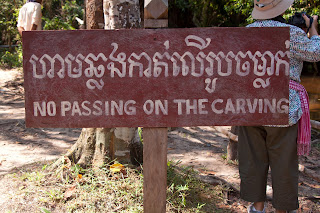
The lingas are symbols of the god Shiva and his powers of creation. They supposedly were meant to symbolically fertizile the sacred waters that flow from Phnom Kulen to the plain below. We were told that close to two kilometers of the stone stream bed has been sculpted with hundreds of these stone lingas or Hindu phallic carvings said to date back to the tenth century.

Some of the carvings are just the lingas, or the male symbol. Others incorporate the yoni or female form. The first image above shows a number of recessed yoni, each with a linga inside. The one just above has a large yoni with a number of lingas inside it. If you look closely at the image below, you can see the yoni just below the water's surface. If it once held a linga, it has been broken off.
Alongside the river, we came upon this most interesting sign. We weren't quite sure how to take it, but were careful not to "pass" on the carving.
After leaving the river, we traveled a short distance to Prea Ang Tho, a 16th century Buddhist shrine popular with Cambodians. The linga/yoni motif is present here, also. Our guide, who introduced himself as "John Bryant," demonstrates to some tourists how one fills a dipper with water flowing from the sacred yoni, then pours it over the linga as an act of worship, or perhaps to ensure good fortune.
The shrine is also a gathering place for beggars, who come by moto, pickup truck, "iron cow" or on foot to take their places on the steps. Many are old or crippled, but a number are mothers with young children. It's a sobering reminder that Cambodia is still a very poor country and has not yet been able to provide adequately for many of the unfortunate among its citizens.
Prea Ang Tho features a giant reclining Buddha that rests atop a large boulder. Unfortunately, the only access is a steep, narrow stairway. Since a line of worshippers were waiting to ascend, we opted not to make the climb. Instead, we admired the spectacular flowers, listened to musicians playing traditional instruments and browsed among the stalls filled with handicrafts and "medicinal" offerings, which often consisted of blood and body parts of forest animals.


Our next stop was a lovely waterfall that was obviously very popular with the local people. All ages were enjoying the spot. Young children and babies played in the swift stream in spite of the fact that only a few yards downstream the water rushed over another precipice to a pool 40 or so feet below! But Cambodian children seem to have an instinct for self-preservation. Not one came even close to tumbling over or had to be snatched away from disaster by a concerned parent.









No comments:
Post a Comment